�
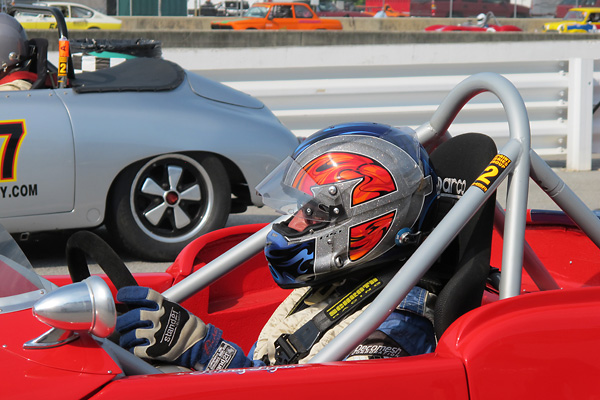
�
Larry Ligas' 1961 Daimler SP250 Vintage Racecar
� � Owner: Larry Ligas� City: Pinellas Park, Florida
� Model: 1961 Daimler SP250
� Engine: Daimler 2.5L V8
� Restored and race prepared by: Predator Racing�
�
The First Cut is the Deepest
��
Larry Ligas was just fifteen years old in 1974 when he and his father decided to purchase a�
1961 Daimler SP250 for the princely sum of $200. The seller's documents weren't quite in order,�
so the Ligas men put down $100 and took possession with agreement that they'd pay the�
remaining $100 upon receipt of the car's title. The car needed to be repaired and restored,�
and anyhow Larry wasn't quite driving age. With youthful enthusiasm, Larry dug right into�
the restoration project and things came together quickly, but the title was still missing as�
the restoration neared completion. Larry was forced into the six-month process of having a�
replacement title issued. There was a plus side to this: Larry learned the complete�
ownership history of his car and that all four previous owners had lived in St. Petersburg. �
�
Larry drove his Daimler SP250 throughout his high school years. He grew up with it. It�
carried him on dates while he romanced his future wife. Although other Daimlers and countless�
Jaguars have come and gone from the family's garage, Larry kept hold of his venerable SP250�
and it remains a sentimental favorite.�
�
In 1998, Larry and business partner David Hinton founded Predator Performance Racing Inc.�
of Largo, Florida. Predator grew into one of the nation's premier Jaguar performance�
and race preparation shops and completed many high-end Jaguar restorations.�
�
Larry's idea of turning his first SP250 into a vintage racecar originated right about the�
same time Predator Performance was founded, but of course client cars always came first.�
The Daimler's preparation waited on the back burner until about two years ago.�
We photographed Larry's Daimler SP250 on its third race weekend, during the 2012 "Mitty"�
at Road Atlanta.�
�
�
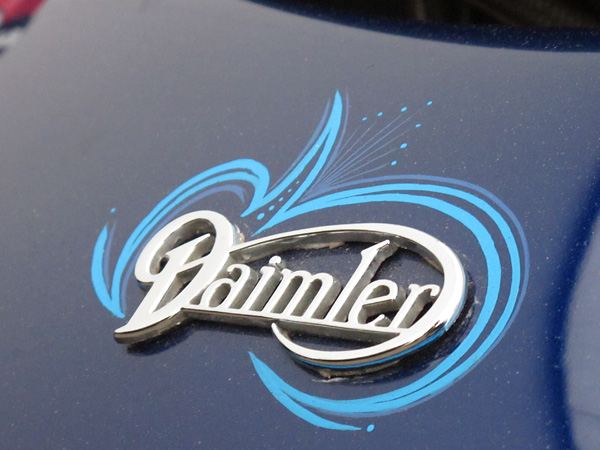
�
Daimler Motor Company Limited was an independent British car manufacturer from 1896 through 1959.
�
Daimler was acquired by Jaguar Cars Limited in 1960. The Daimler brand has been applied to limited
�
production Jaguar luxury cars as recently as late-2009. In its long history, Daimler only built
�
one sports car model: 2,648 Daimler SP250s were built between 1959 and mid-year 1964.
�
�
Daimler SP250 production spanned three distinct series of cars. Early cars were plagued with�
frame stiffness issues. As their frames flexed, so did their fiberglass bodies and there were�
many reports of doors flying open. Shortly after purchasing the Daimler Motor Company Ltd.,�
Jaguar announced a recall and also made a running change in production. This change phased-in�
during April 1961. In addition to stiffer frames, Series B Daimler SP250s also came with more�
robust rear axles. Most, but not all of the Series A Daimler SP250 frames were reinforced during�
the recall, but Larry's car (chassis number 194) was somehow missed. Its chassis wasn't stiffened�
until Predator Performance began preparing it for vintage racing.�
�
�
�
Want to see more articles like this? BritishRaceCar.com is funded by readers like YOU.
�
To contribute to our operating fund, PLEASE click here and follow the instructions.
�
(Suggested contribution is twenty-five bucks per year. Feel free to give more!)
�
�
 �
�
�
�
Features and Specifications
�| Engine: | �original numbers-matching Daimler 2.5L V8 rebuilt by Ted Wenz.�
Original crankshaft.�
Ross Racing forged pistons.�
Crower connecting rods.�
Approximately 12:1 static compression ratio.�
Thinner valve stems to help flow.�
ATI Super Damper harmonic balancer, modified to suit the Daimler engine.�
Four Weber 44IDF two-barrel carburetors mounted on custom fabricated intake manifolds. �
Mallory magnetic pick-up breakerless electronic distributor, modified to suit the Daimler engine.�
MSD Blaster 2 ignition coil. �
MSD 8.5mm Super spark plug wires.�
MSD6AL capacitive discharge ignition system.�
Dry sump lubrication system.�
Weaver Brothers three-stage dry sump oil pump.�
Peterson Fluid Systems dry sump oil tank.�
Original Daimler oilpan, modified with windage tray and two scavange pick-ups. �
K&N HP-3001 oil filter.�
Remote mount.�
Moroso breather bottle.�
| �
| Cooling: | �custom fabricated AFCO dual-pass crossflow aluminum radiator.�
Custom fabricated aluminum header tank.�
Mocal 25-row oil cooler.�
| �
| Exhaust: | �custom fabricated stainless steel 2-stage step-up four-into-one headers.�
Y-pipe.�
Dr Gas "Boom Tube" exhaust tip.�
| �
| Transmission: | �Jerico Performance Products dog ring four-speed gearbox with lightweight "qualifying" gears.�
5.5" twin-disk clutch.�
Custom flywheel.�
| �
| Rear axle: | �Austin Healey 3000 axle housing.�
3.909:1 rear axle ratio.�
Phantom Grip limited slip differential.�
| �
| Front Susp.: | �stock wishbones, except with lower arms modified to mate with coilover shock absorbers.�
Nylon control arm bushes. �
HAL/QA1 double-adjustable coilover shock absorbers.�
AFCO 2 5/8" diameter coil springs.�
Speedway Engineering modular anti-sway bar.�
Converted to rack and pinion steering.�
Standard hubs, re-drilled from 4x4" to 5x4" bolt pattern.�
| �
| Rear Susp.: | �original semi-elliptic leaf springs, now mounted on sliders instead of shackles at the rear.�
QA1 telescopic shock absorbers.�
Watts linkage, with links made by AFCO.�
| �
| Brakes: | �(master) dual CNC 3/4" bore master cylinders with bias bar and TB&C remote bias adjustment knob. � (front) Brembo (Porche 944 front) four piston calipers with Coleman vented rotors. � (rear) Brembo (Porche 944 rear) four piston calipers with Coleman vented rotors. | �
| Wheels/Tires: | �American Racing Torq Thrust II aluminum wheels, with a Ford 5-bolt x 4" bolt pattern.�
Hoosier T.D. S 25.5/8.5/15 bias ply racing tires.�
| �
| Electrical: | �Optima red top battery.�
Denso polished 93mm alternator.�
Quarter Master reverse-mount gear reduction starter motor�
(Chevrolet spec.)�
Manual reset circuit breakers on ignition, fuel pump, and headlight circuits.�
| �
| Instruments: | �(left to right) �
Auto-Meter Sport-Comp water temperature gauge (120-240F),�
oil temperature gauge (140-280F), and�
oil pressure gauge (0-100psi),�
Auto-Meter Sport-Comp Monster tachometer (0-10,000rpm) with shift-light controller.�
Auto-Meter Sport-Comp miniature voltmeter (0-18V).�
| �
| Fuel System: | �Fuel Safe Systems EC112 twelve gallon fuel cell.�
Holley "Blue" 110gph electric fuel pump.�
Holley adjustable fuel pressure regulator.�
| �
| Safety Eqmt: | �Sparco steering wheel.�
Schroth Racing six point safety harness.�
Sparco Pro 2000 fiberglass racing seat.�
SafeCraft centralized fire suppression system.�
| �
| Weight: | �almost exactly 2000 pounds, wet.�
| �
| Racing Class: | �HSR "2H".�
| �
Engine Installation
��
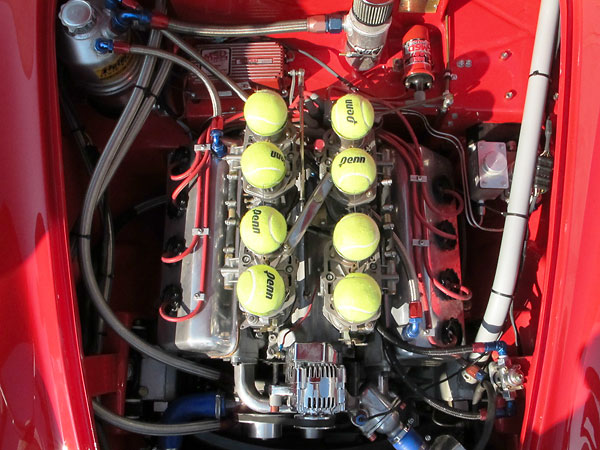
�
The car's original (numbers-matching) Daimler 2.5L V8 engine has been rebuilt by Ted Wenz.
�
These engines feature a 3.0" (76.2mm) cylinder bore and a 2.8" (69.85mm) piston stroke.
�
Stock compression ratio was only ~8.2:1, but this one has been increased to ~12:1.
�
As currently set-up, this engine is producing approximately 245bhp.
�
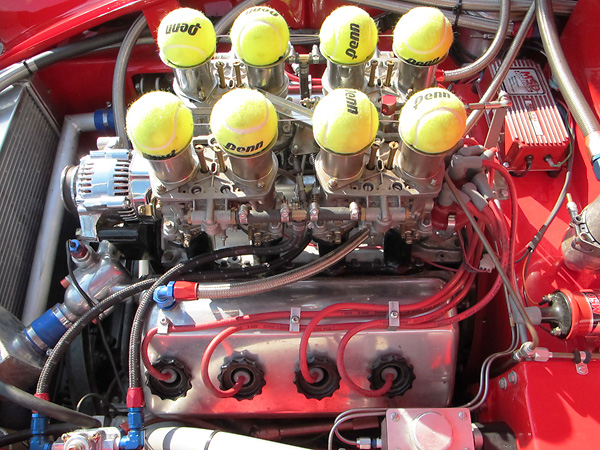
�
Daimler's V8 engines featured aluminum cylinder heads with hemispherical combustion chambers.
�
Iron engine blocks with pushrod operated lifters were quite conventional, and at 419 pounds
�
(not including flywheel) these weren't especially lightweight engines by any standard.
�
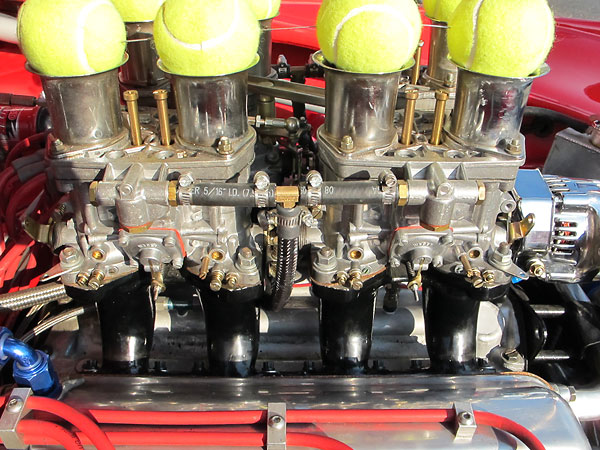
�
Four Weber 44IDF two-barrel carburetors mounted on custom fabricated intake manifolds.
�
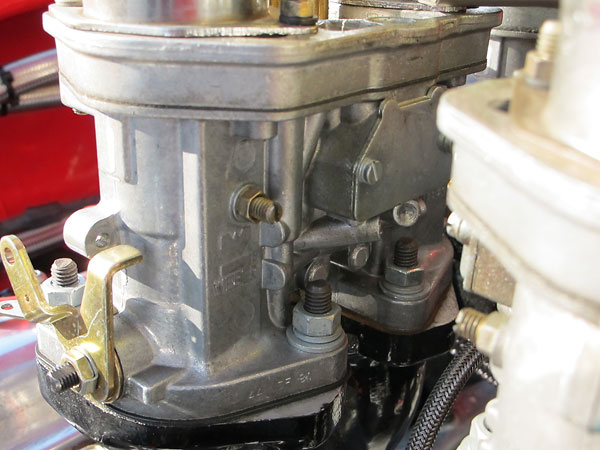
�
The base of each carburetor is stamped "44 IDF 81" which equates to Weber part number 18990.035.
�
44 is the diameter of the thottle plate. The IDF series are a two barrel synchronous downdraft design
�
with central float chambers, diaphragm type accelerator pumps and ball bearing throttle shafts.
�
�
�
Want to see more articles like this? BritishRaceCar.com is funded by readers like YOU.
�
To contribute to our operating fund, PLEASE click here and follow the instructions.
�
(Suggested contribution is twenty-five bucks per year. Feel free to give more!)
�
�
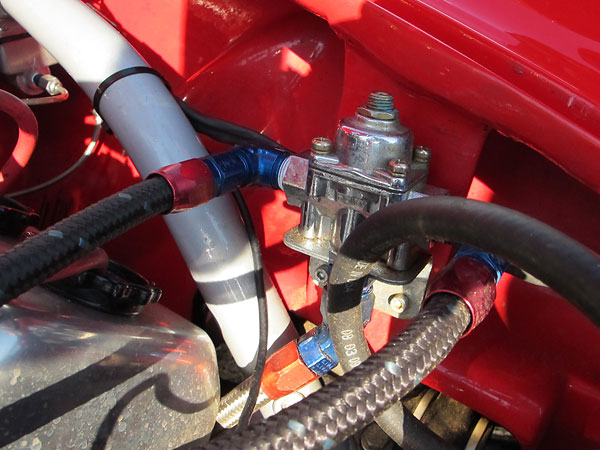
�
Holley adjustable fuel pressure regulator.
�
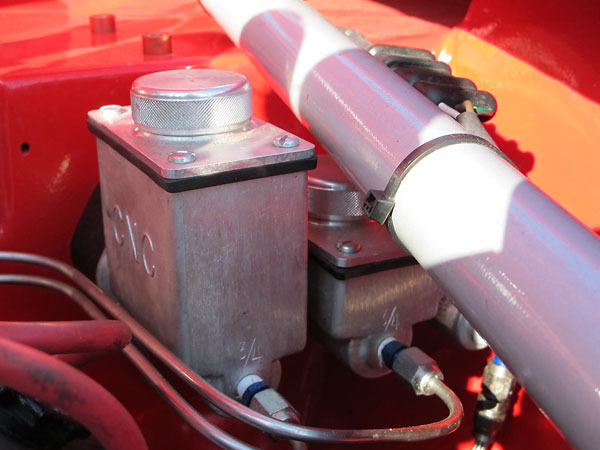
�
Dual CNC 3/4" bore brake master cylinders.
�
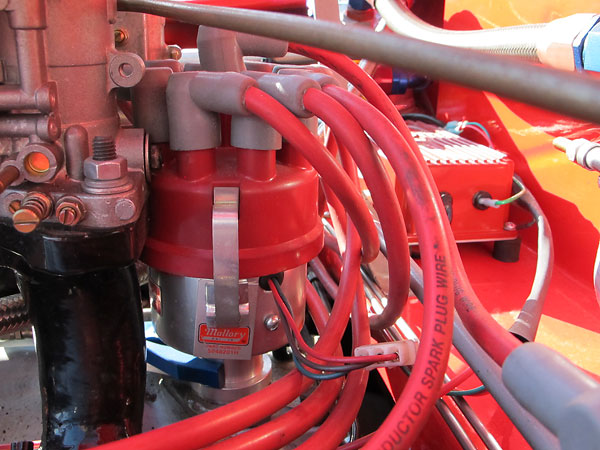
�
Mallory magnetic pick-up breakerless electronic distributor, part number 5048201H. Note:
�
this is Mallory's small block Chevy spec alternator, modified to fit the Daimler engine.
�
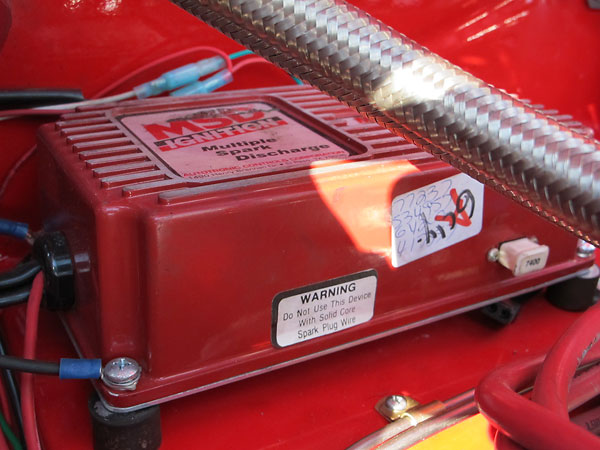
�
MSD6AL capacitive discharge ignition module, with 7400rpm rev limiter chip installed.
�
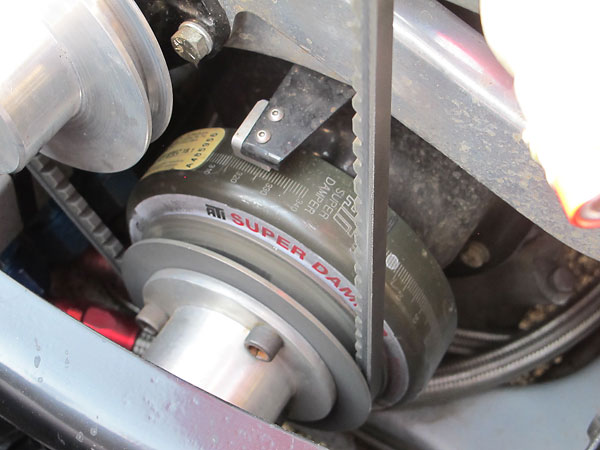
�
ATI Super Damper harmonic balancer. Note: this is ATI's small block Ford spec damper,
�
except with its keyway slot widened to mate with the Daimler crankshaft.
�
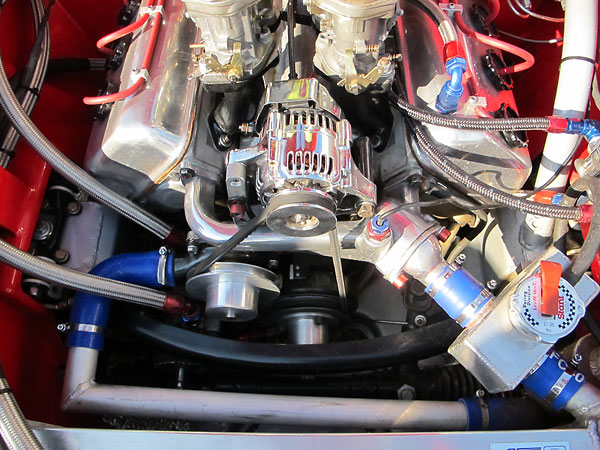
�
Polished 93mm Denso alternator.
�
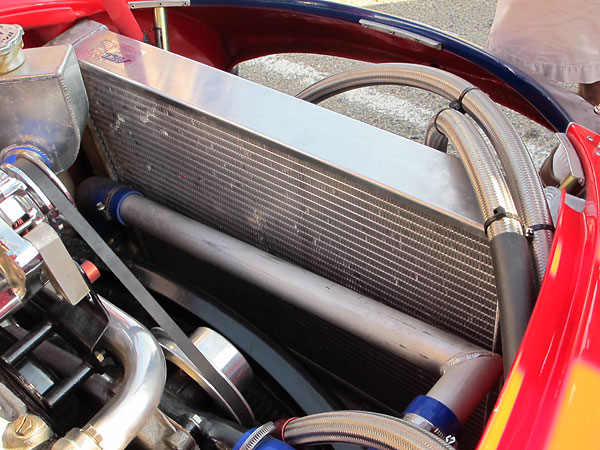
�
Larry says this custom AFCO dual-pass crossflow aluminum radiator may be overkill.
�
So far, he has observed that his water temperature seems to run at a consistant 150°F.
�
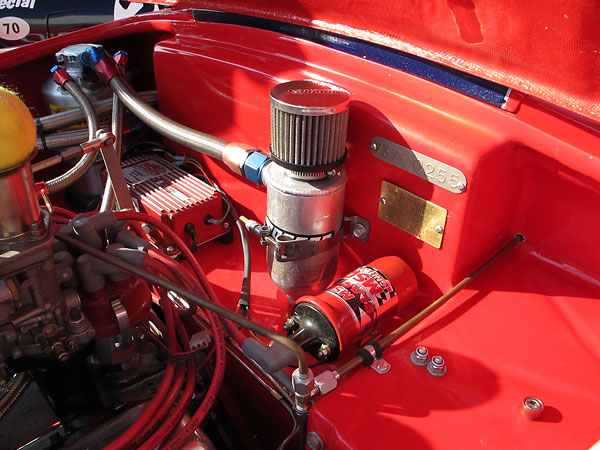
�
MSD Blaster 2 ignition coil.
�
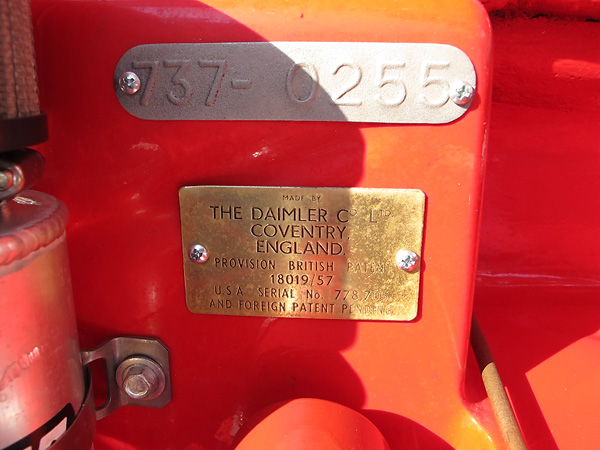
�
737-0255 - Made by: The Daimler Co. Ltd., Coventry, England
�
Provision British Patent 18019/57, U.S.A. Serial No. 778,705, and Foreign Patent Pending
�
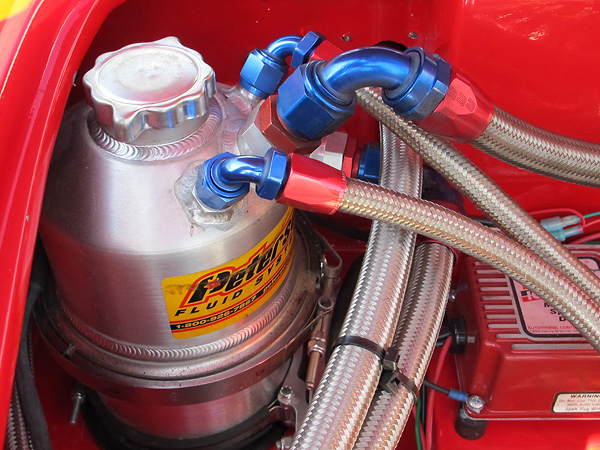
�
Peterson Fluid Systems 6" diameter dry sump oil tank.
�
Please support the sponsoring companies who make www.BritishRaceCar.com possible, including:
� �
 �
�
�
�
�
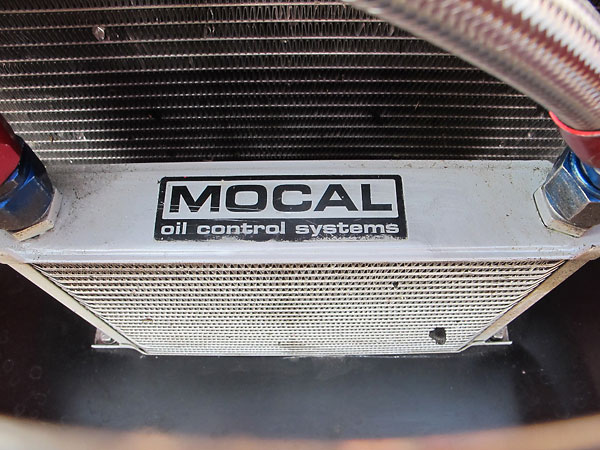
�
Mocal Oil Control Systems.
�
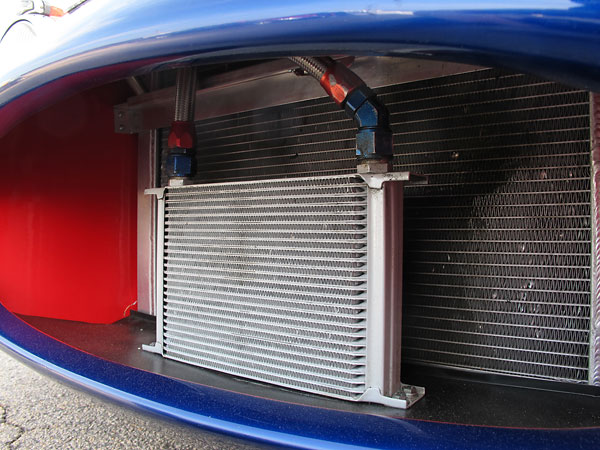
�
Larry says his Mocal 25-row oil cooler keeps the oil at a consistant 210°F.
�
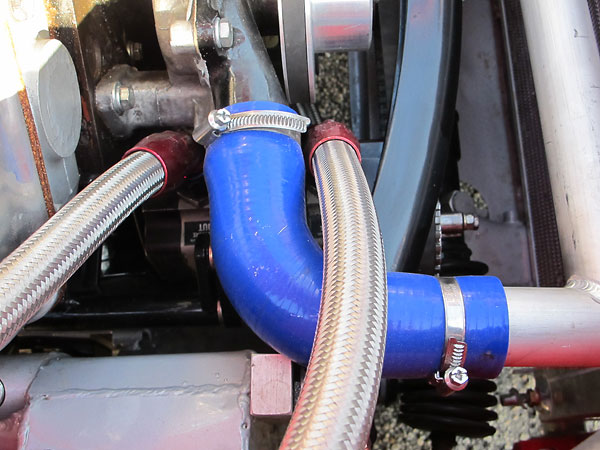
�
Weaver Brothers three-stage oil pump for the dry sump lubrication system.
�
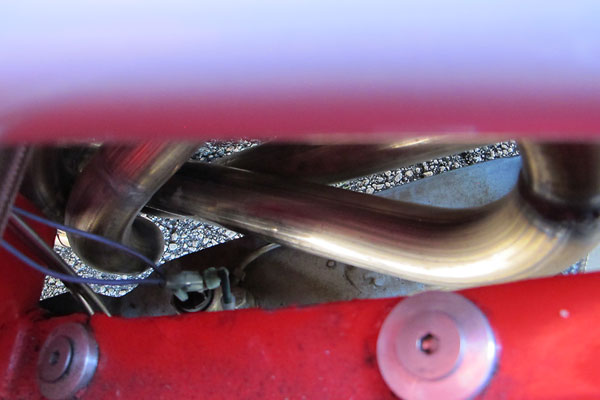
�
Larry fabricated these stainless steel, 2-stage step-up, four-into-one headers. They're
�
designed to bolt onto the cylinder heads before the heads are mated to the engine block.
�
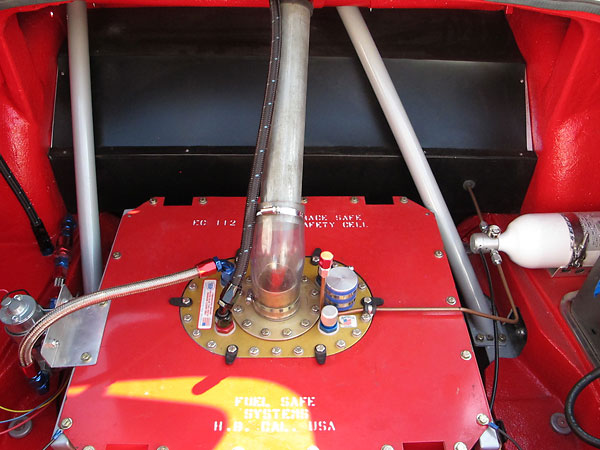
�
Fuel Safe Systems EC112 12-gallon fuel cell measures 20.375" X 17.625" X 9.375".
�
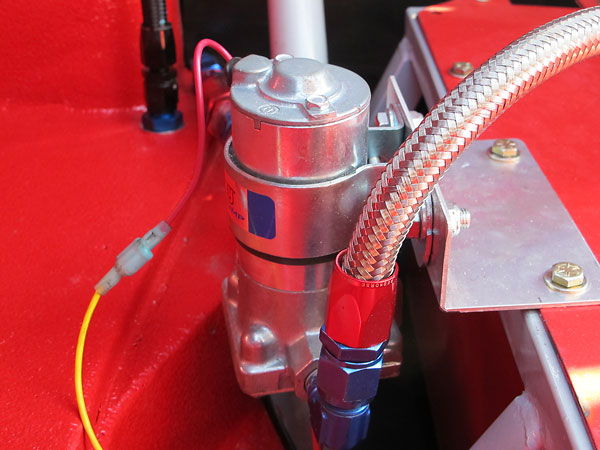
�
Holley "Blue" 110gph electric fuel pump.
�
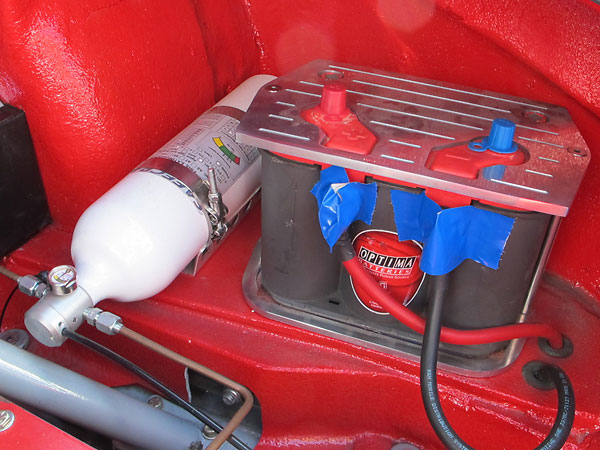
�
Optima red top battery.
�
�
Front Suspension, etc.
��
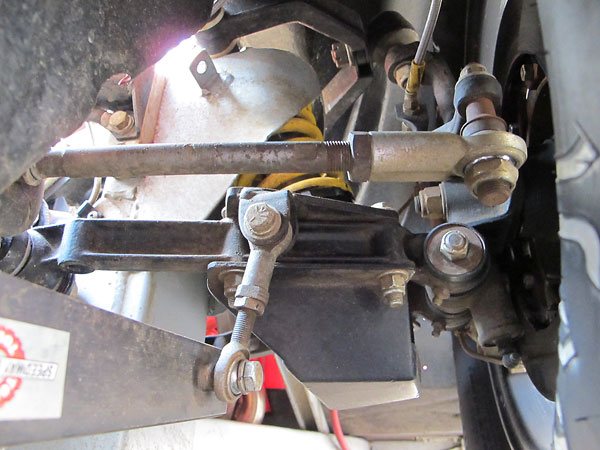
�
These front wishbones are essentially stock, except with specially fabricated spring pans
�
installed to accommodate coilover shock absorbers. Also, they're mounted on Nylon bushings.
�
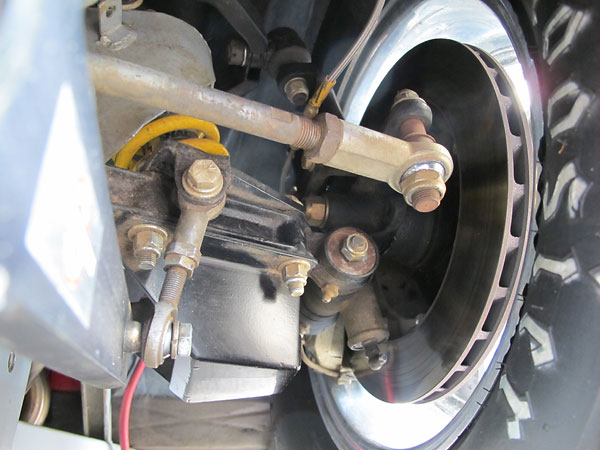
�
AFCO 2 5/8" diameter springs slip into the Daimler's stock spring pockets, but at their lower
�
end they mate to the threaded perchs of HAL/QA1 double-adjustable coilover shock absorbers.
�
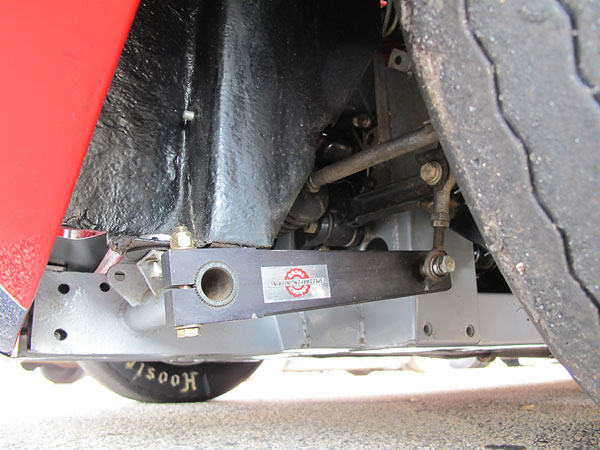
�
The center section of this Speedway Engineering modular anti-sway bar slid right into an original
�
tubular crossmember. No bushings, bearings, or pillow blocks required.
�
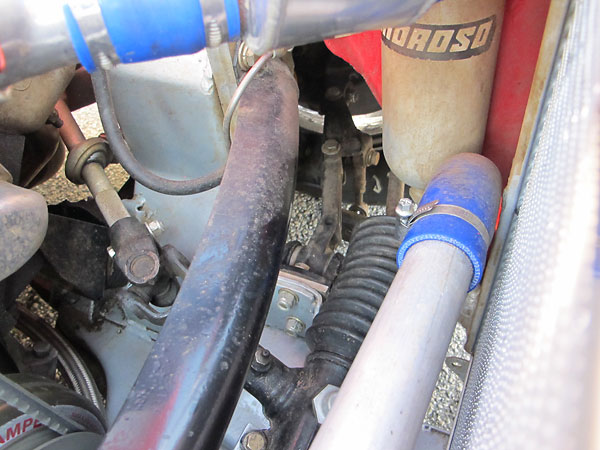
�
One of the first changes Larry made for racing was conversion to rack and pinion steering.
�
But what model car donated the rack? We're not sure.
�
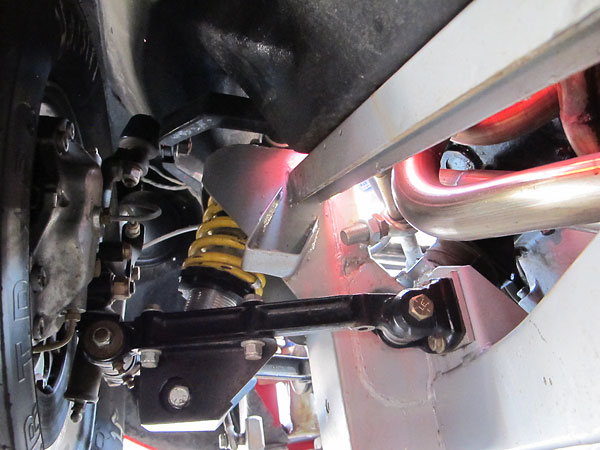
�
Larry likes the Daimler's stock front end geometry, so he hasn't altered caster, camber, etc.
�
In this view you can see the camber adjustment shims, and you can also see Brembo four piston
�
brake calipers from a Porsche 944 donor car Larry uses with Coleman vented rotors.
�
�
�
Want to see more articles like this? BritishRaceCar.com is funded by readers like YOU.
�
To contribute to our operating fund, PLEASE click here and follow the instructions.
�
(Suggested contribution is twenty-five bucks per year. Feel free to give more!)
�
Rear Suspension
��
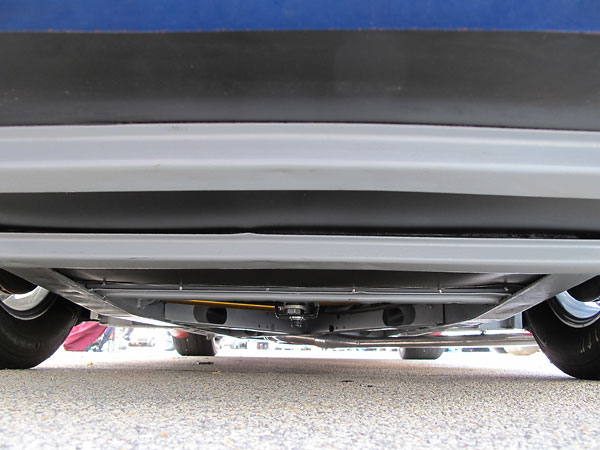
�
Daimler SP250s feature under-slung frames and they don't offer a great deal of rear axle travel.
�
This example is on its third rear axle. The original Series A axle suffered a sheared stub axle
�
quite early on. A previous owner installed a Triumph TR3 axle, but it was really too narrow for
�
the car. Larry installed an Austin Healey 3000 axle about thirty years ago, and is still using it.
�
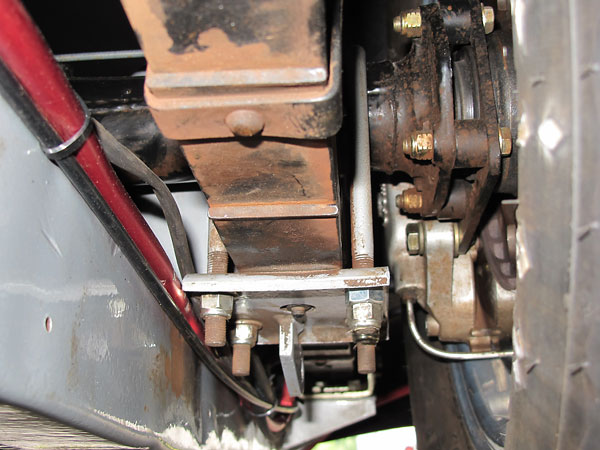
�
All Daimler SP250s were equipped with four wheel disk brakes, so Larry installed disk brakes on this
�
Healey axle with Brembo calipers from the rear of a Porsche 944. Billet aluminum adapter hubs were
�
custom made to convert the Healey axle to a Ford 5-lug bolt pattern.
�
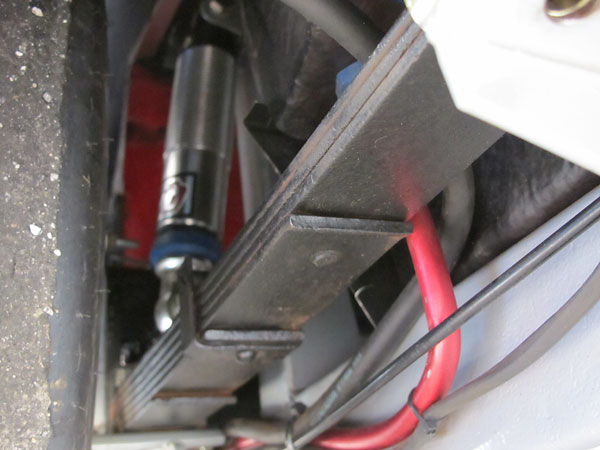
�
Lever shock absorbers have been replaced with QA1 telescopic shocks. In 38 years of ownership, the
�
original shock absorber installation proved to be one of the car's weak links. They to wallow out
�
their mounting holes. These shock absorbers are set much stiffer than original.
�
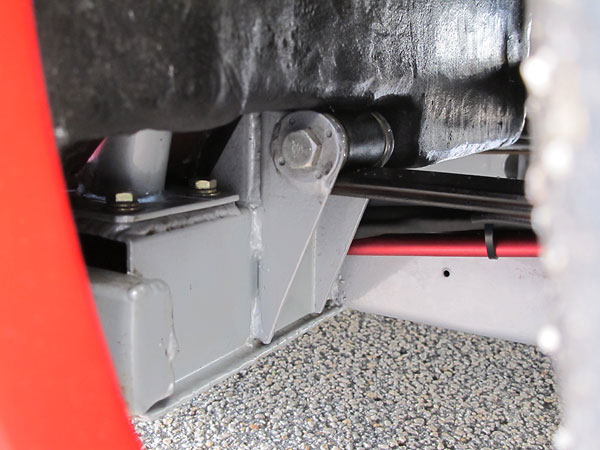
�
Larry's Daimler SP250 is still running on its standard equipment, original rear springs.
�
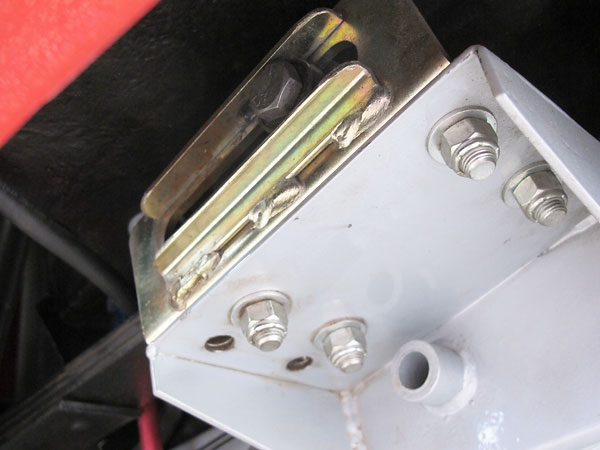
�
The rear ends of the leaf springs are mounted on sliders now, rather than on spring shackles.
�
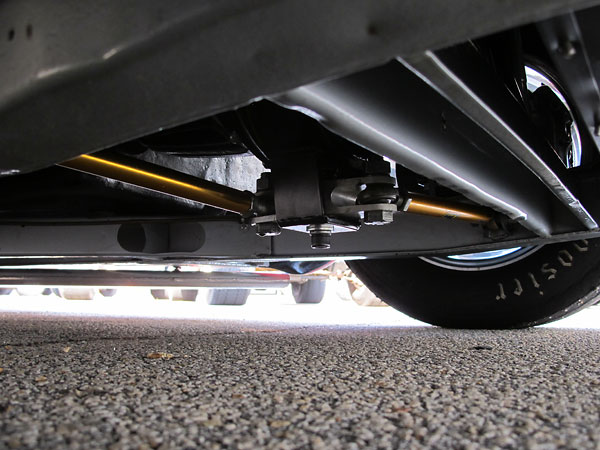
�
Custom Watt's linkage mechanism, with links made by AFCO. Larry says it works real nice.
�
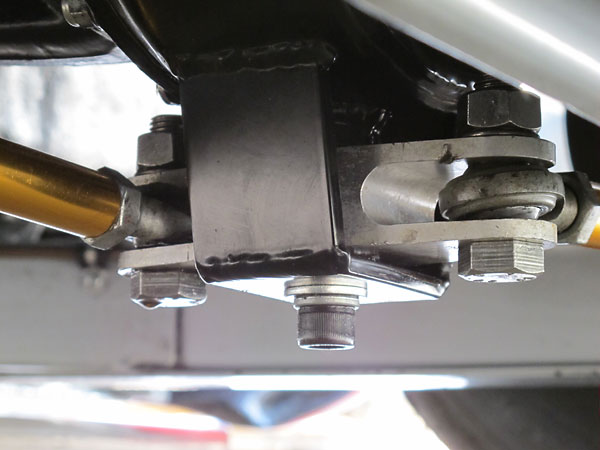
�
The Watt's link pivots on a vertical pin, below and attached to the axle. Its mounting height
�
defines the rear suspension's instantaneous roll center. There's no rear anti-sway bar.
�
�
Interior
��
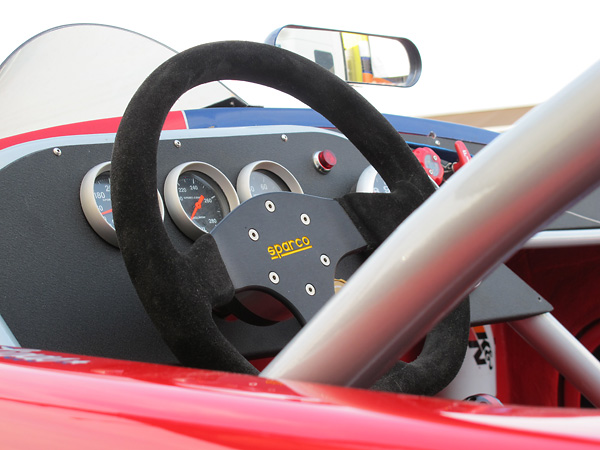
�
Sparco suede-wrapped, D-shaped steering wheel.
�
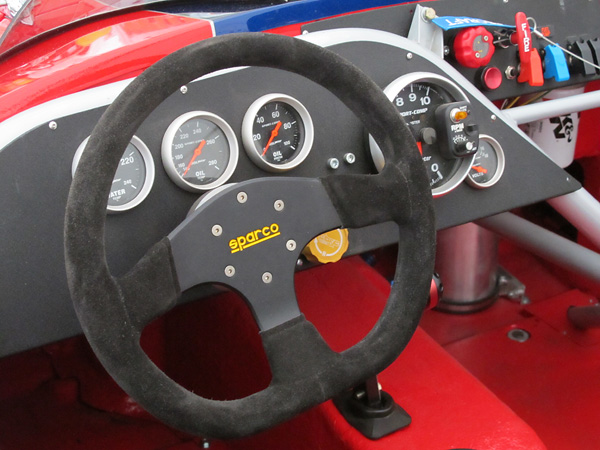
�
Behind the steering wheel: TB&C labeled remote brake bias adjustment knob.
�
(Tilton Brake and Controls is the brake division of Tilton Engineering.)
�
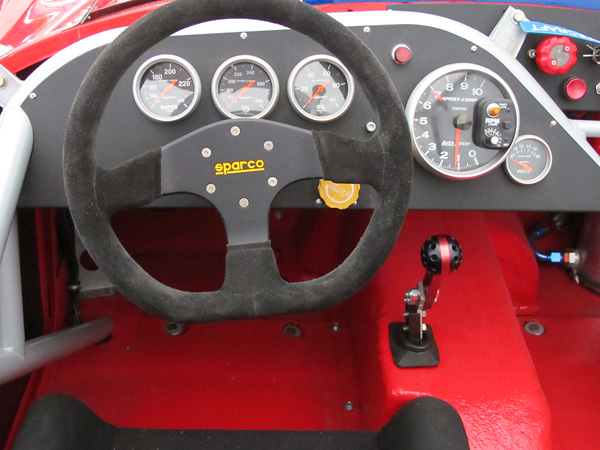
�
Auto-Meter Sport-Comp water temperature, oil temperature, and oil pressure gauges. Auto-Meter
�
Sport-Comp "Monster" tachometer with shift-light controller. Auto-Meter Sport-Comp miniature voltmeter.
�
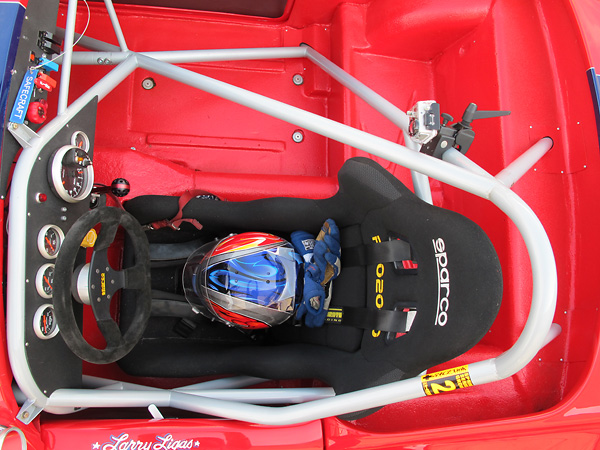
�
Sparco's Pro 2000 fiberglass racing seat weighs 19.7 pounds and is FIA approved.
�
It's also available in a carbon fiber version which weighs 13.7 pounds.
�
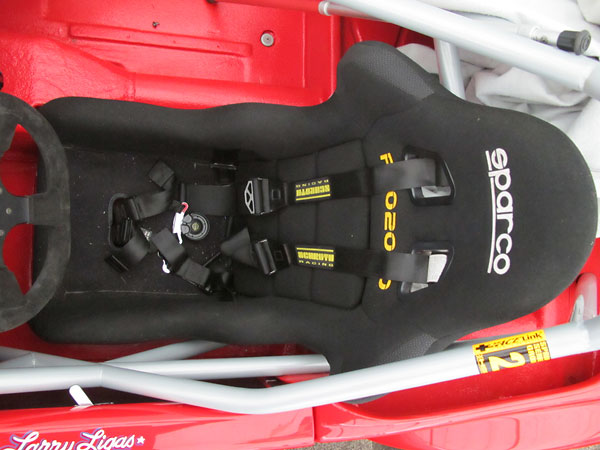
�
Schroth Racing six point safety harness.
�
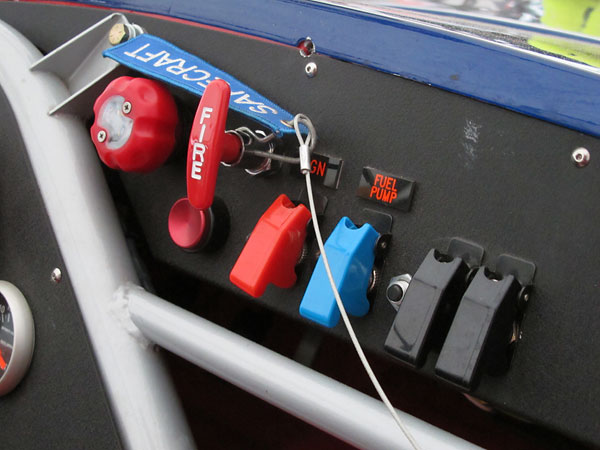
�
Top row: kill switch knob and fire system pull cable. Bottom row, left to right: starter push-button switch,
�
ignition switch, fuel pump switch, headlight switch, and running light switch. Push-button type manual
�
reset circuit breakers are mounted next to the ignition, fuel pump, and headlight switches.
�
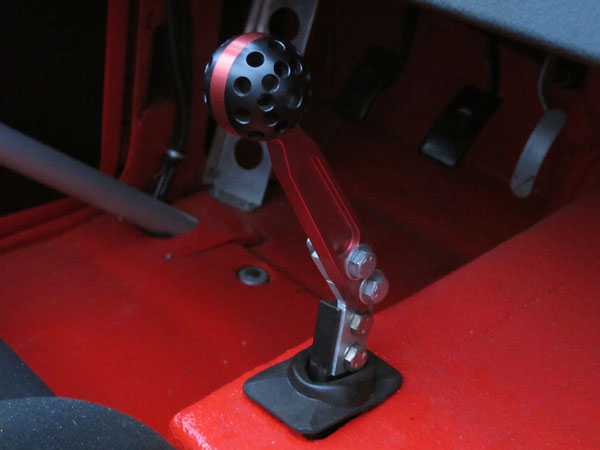
�
This gear shifter mates to a Jerico Performance Products four speed dog-ring gearbox.
�
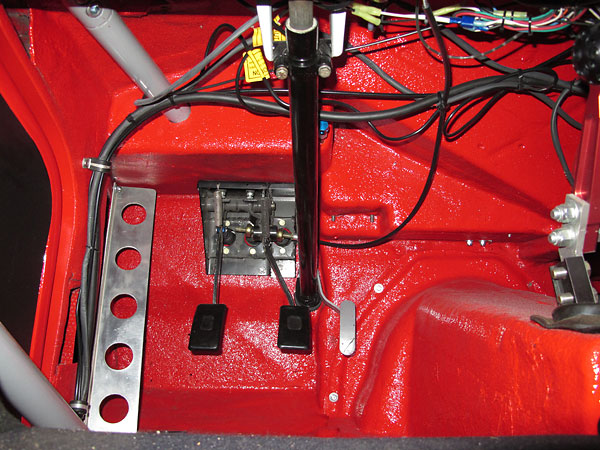
�
Original Daimler brake pedal assembly has been modified to accommodate dual master cylinders,
�
and a Tilton brake bias adjustment mechanism has been welded into the original brake pedal.
�
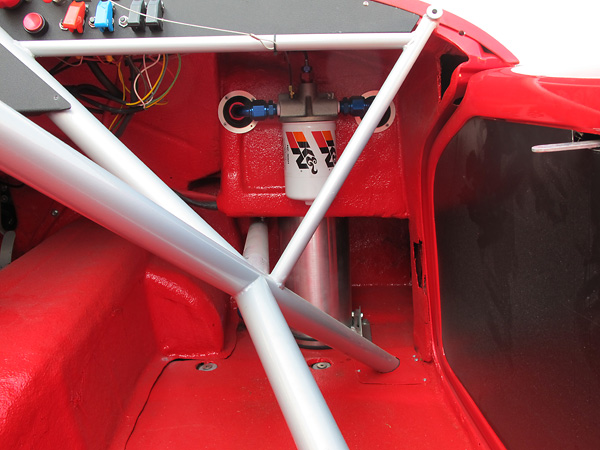
�
Foreground: remotely mounted K&N HP-3001 oil filter installed with Seals-It pass-through seals.
�
Background: the Peterson Fluid Systems engine oil reservoir extends down to the floorboard for a
�
total oil capacity of 2.5 gallons. Peterson manufactures dry sump oil tanks with various diameter
�
and length dimensions. Generally, taller tanks are more effective at de-aeration of crankcase oil.
�
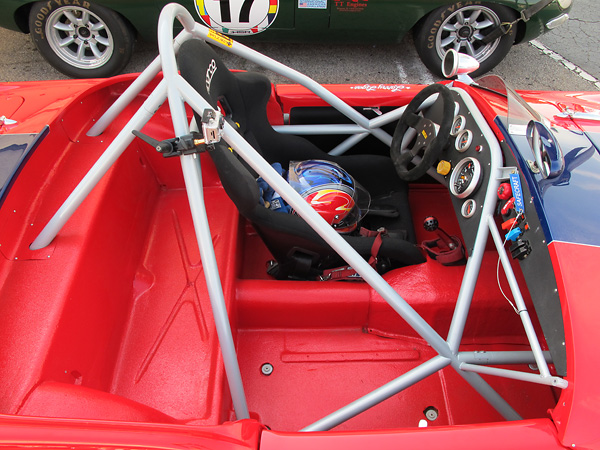
�
Although richly appointed in some respects, adjustable steering columns and windscreen washers weren't
�
provided on the Daimler SP250 model until "B-spec" production commenced in April 1961. Heaters
�
weren't standard equipment until "C-spec" production commenced in April 1963. (Larry's SP250
�
was delivered from the factory with an optional-equipment heater.)
�
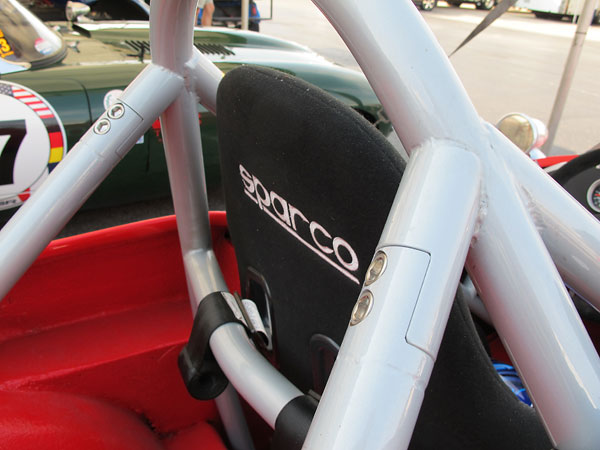
�
Removeable rearward roll-cage braces.
�
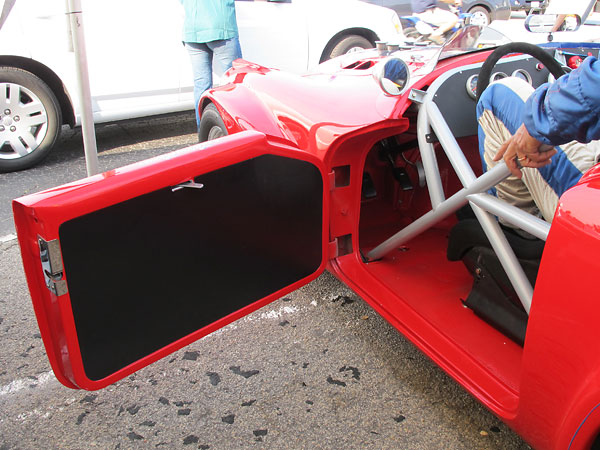
�
A well-crafted roll structure dramatically enhances the car's chassis strength and stiffness.
�
�
Exterior
��
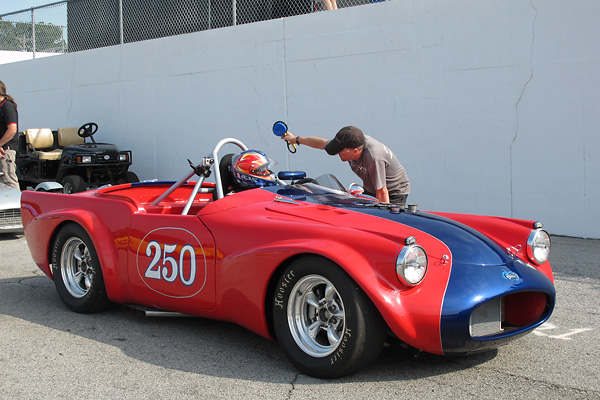
�
We enjoyed watching Larry race his SP250 at the 2012 Mitty at Road Atlanta, where his
�
best lap was 1:45.757, for an average of 86.5mph over the challenging 2.54 mile circuit.
�
He finished fourth place overall and second place in his class, in a field of 52 cars.
�
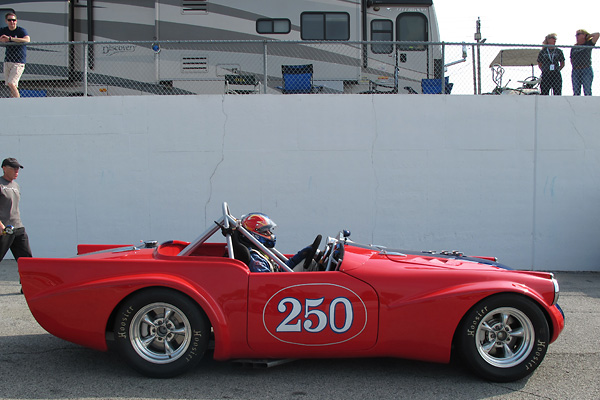
�
The 2012 Mitty was Larry's third race in his newly completed Daimler SP250 racecar.
�
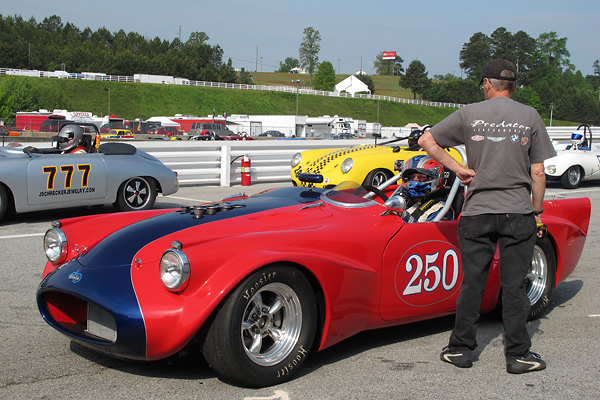
�
Larry Ligas and business partner Dave Hinton operate Predator Performance. Located in Largo
�
Florida, Predator Performance specializes in vintage Jaguar performance and restoration.
�
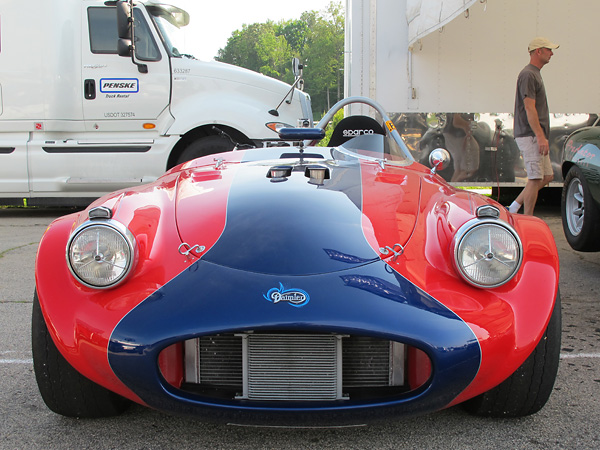
�
Daimler was struggling in the late 1950s. They decided to develop a sports car for the North
�
American market. Three key features: V8 engine, fiberglass body, and tailfins. However,
�
bumpers were an afterthought. Daimler SP250s came without bumpers until April 1961.
�
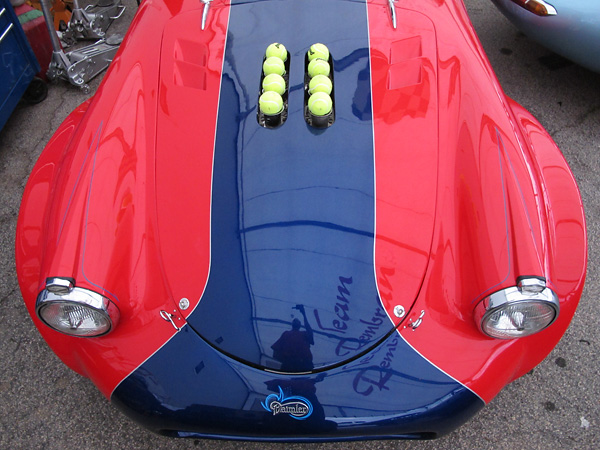
�
Daimler showed their brand new sports car at The New York Auto Show in April 1959, it was badged
�
as a "Dart". Chrysler's Dodge division had used the name Dart on a show car in 1957, and in 1959
�
they were preparing to announce their new compact sedan. It launched as a 1960 model. Result?
�
Daimler dropped the name Dart for North American marketing, and used SP250 instead. In 1960,
�
Jaguar Cars Ltd. acquired a controlling interest in the Daimler Motor Company Ltd.
�
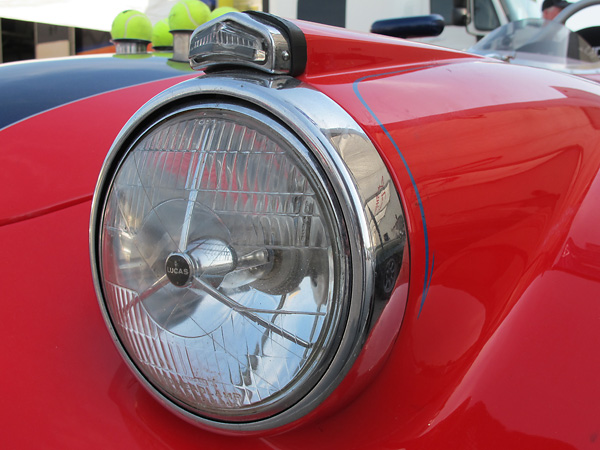
�
Lucas tripod headlamps.
�
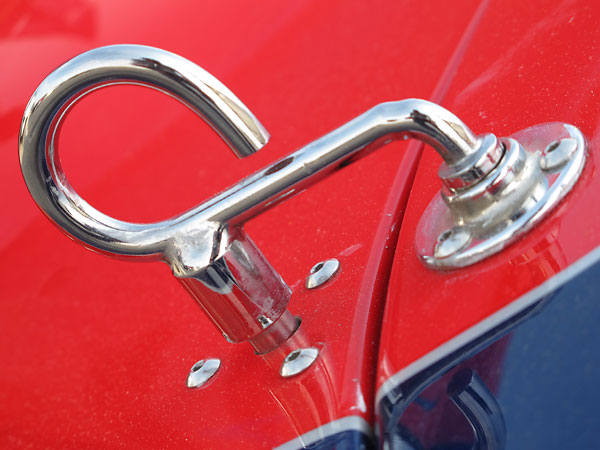
�
Swiveling bonnet hold-down clips.
�
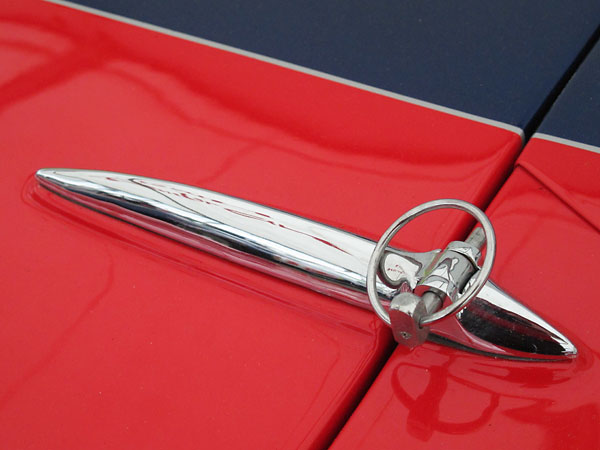
�
Bonnet hinge, with linch pin to facilitate removal.
�
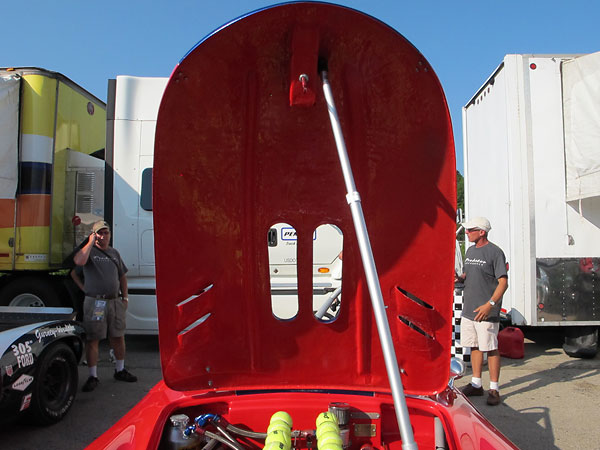
�
Larry made molds off the Daimler's original fiberglass bonnet and boot lid, and then created
�
the new lighter-weight fiberglass panels you see here. This SP250 racecar weighs in at 2000#
�
(with ~5 gallons of fuel). According to published reports, stock Daimler SP250s weighed ~2240#.
�
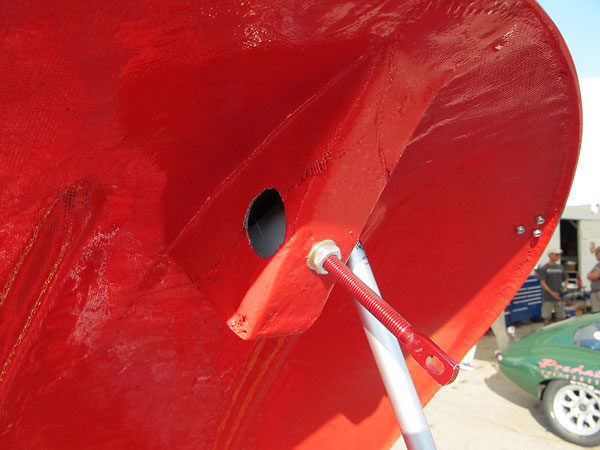
�
Hidden bonnet hold-down.
�
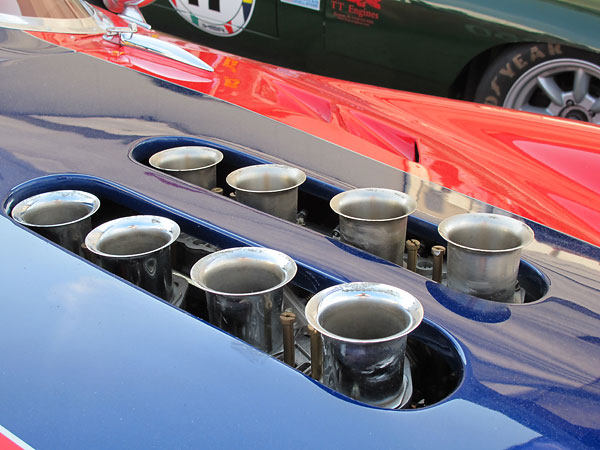
�
Daimler 2.5L V8 engines probably aren't as scarce as you'd expect. At least 20,268 of the
�
little V8 engines were produced between 1959 and 1969. In addition to the 2,648 used in
�
Daimler SP250 sports cars, 17,620 2.5L V8 engines were installed in Daimler saloons.
�
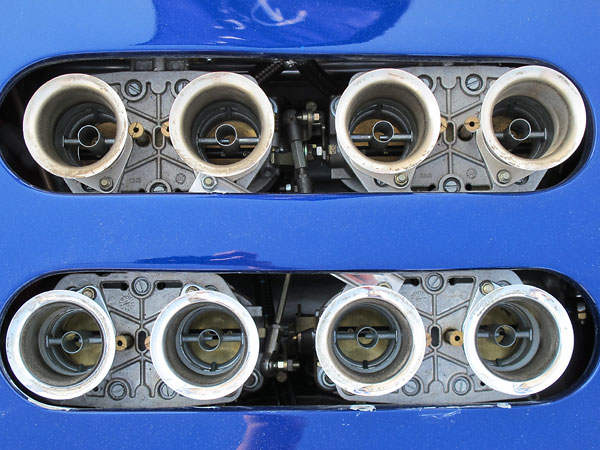
�
Between 1959 and 1968, Daimler also produced at least 2,044 cars with a similar but larger V8.
�
Daimler's 4.5L V8 featured a 0.8" larger cylinder bore (3.8") and a 0.4" longer stroke (2.8").
�
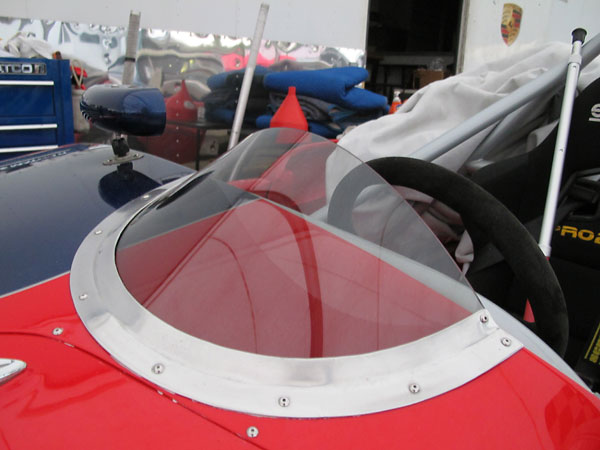
�
Custom low-profile Perspex wind screen.
�
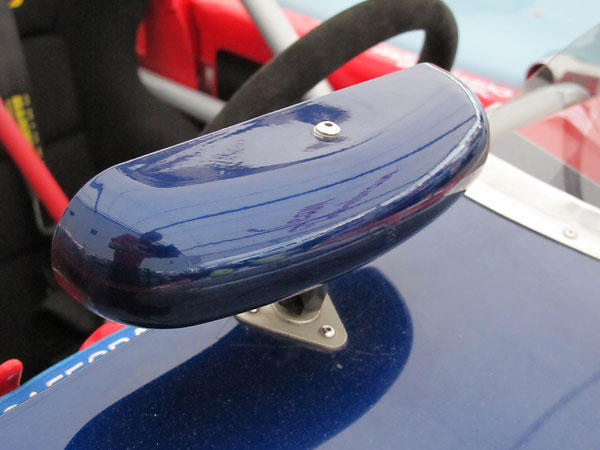
�
SPA Design center mirror.
�
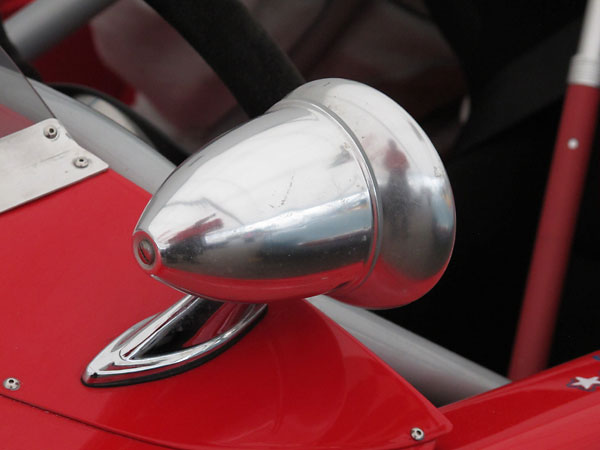
�
Talbot-style chrome bullet mirror.
�
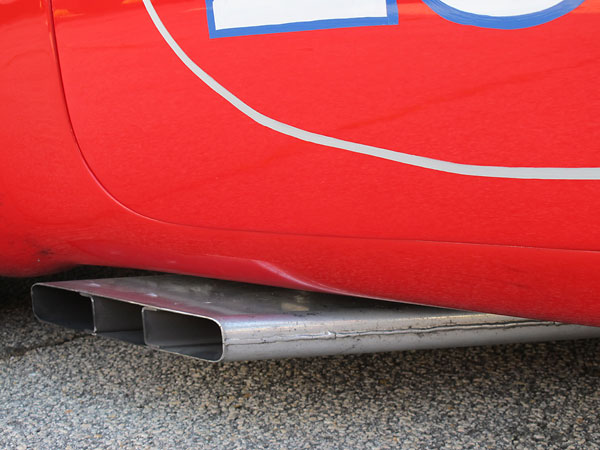
�
Dr Gas "Boom Tube" exhaust tip.
�
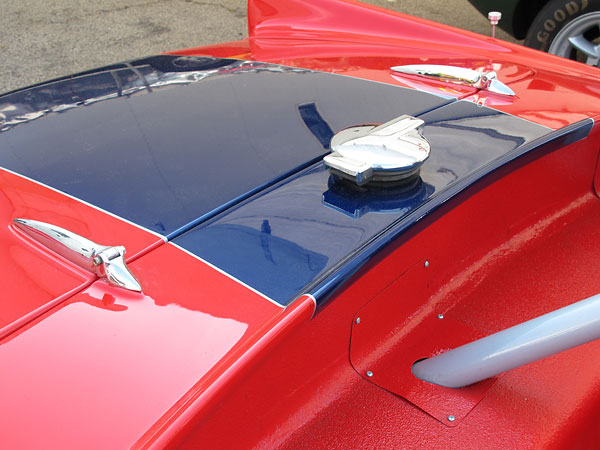
�
Daimler SP250 fuel filler cap.
�
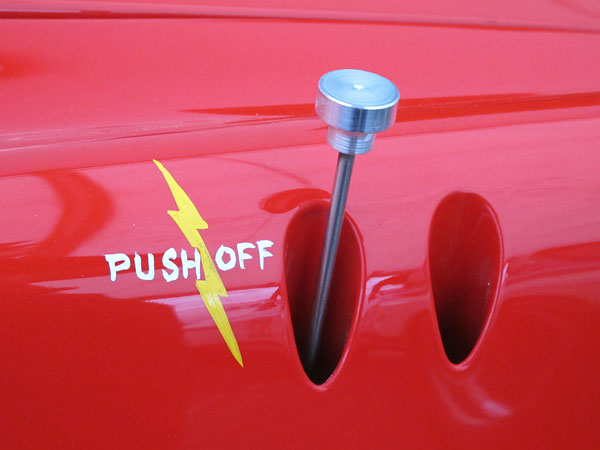
�
Push off.
�
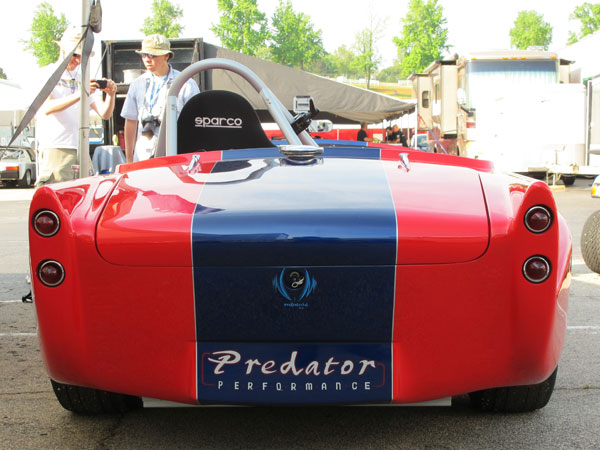
�
The signature of pin-striper Demetrius von Hentschel, signed October 2011.
�
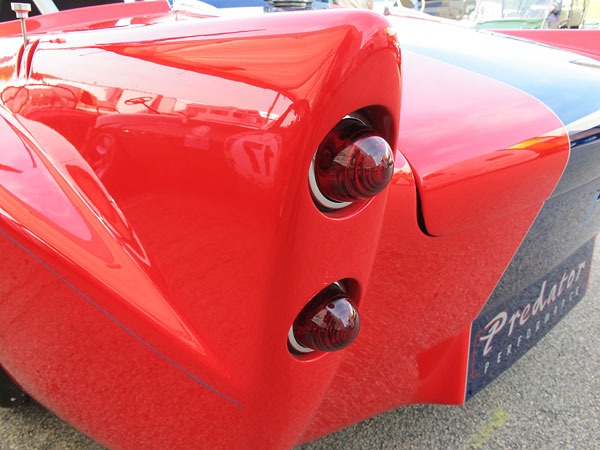
�
Daimler SP250 tail lamps.
�
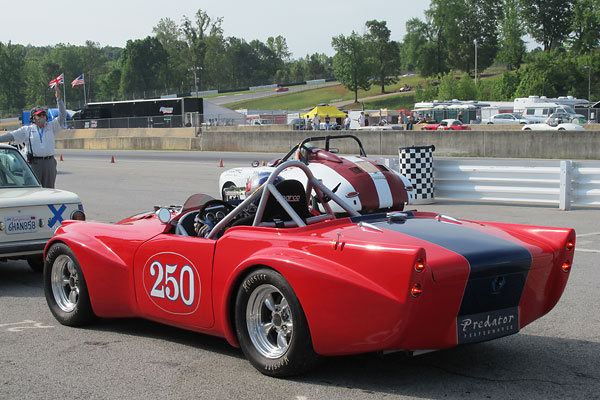
�
Ready to race!
�
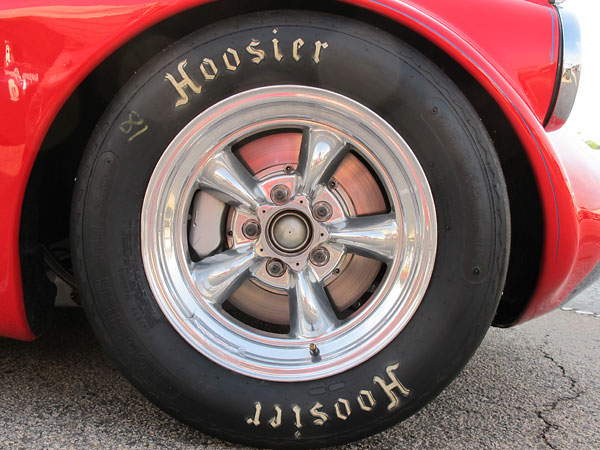
�
American Racing Torq Thrust II aluminum wheels, with a Ford 5-bolt x 4" bolt pattern.
�
Daimler SP250s originally came with 4x4" hubs.
�
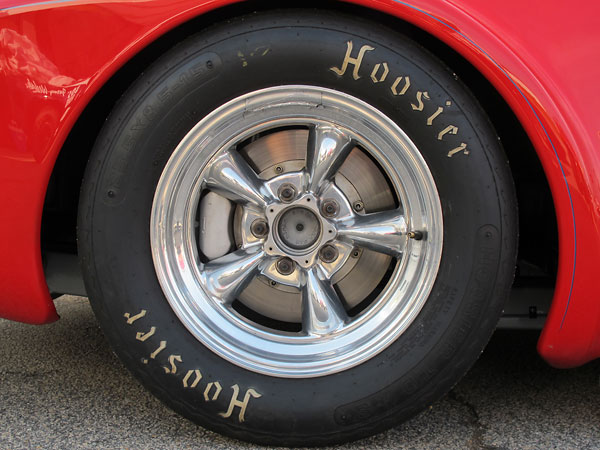
�
Hoosier T.D. "S" bias-ply racing tires. The S stands for stiff sidewall. Custom billet aluminum
�
hub adapters were made to convert the Healey axle from 5x5" to 5x4" wheel lug pattern.
�
�
| �
� 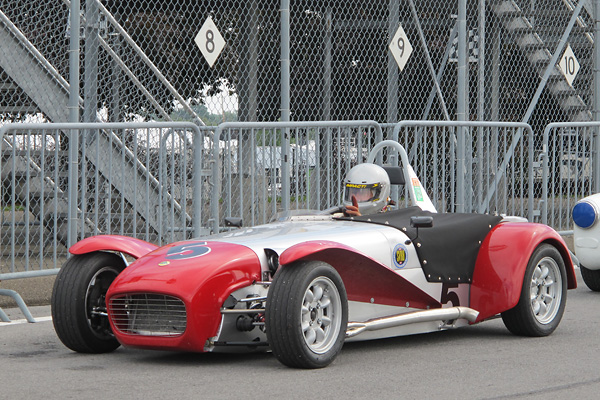 � (Craig Chima's Lotus Seven, as photographed by Curtis Jacobson for BritishRacecar.com) � Did you enjoy this article? We currently have eighty more in process, featuring about 6000 new photos. � But it takes a lot of time and expense to turn photos into articles, and to publish them on the internet. � Please consider making a contribution. Your donation will help us publish more and better articles! � While you're at it, tell us which racecars interest you most. We value the opinions of our funders. � � |
�
All photos are from April 28-29, 2012 when we viewed the car at "The Mitty" at Road Atlanta in Georgia. �
All photos by Curtis Jacobson for BritishRaceCar.com, copyright 2012.�
All rights reserved.
�
| If you liked this article, you'll probably also enjoy these: | �|||||
 | �
Michael Oritt '59 Elva MkIV | �
 | �
Joe Dockman '60 Daimler SP250 | �
 | �
Bernard Bradpiece '63 Elva MkVII | �
| You're invited to discuss anything you've seen here on The British Racecar Motorsports Forum! | �|||||
�
Notice: all the articles and almost all the photos on BritishRacecar.com are by Curtis Jacobson.
�
(Photos that aren't by Curtis are explicitly credited.) Reproduction without prior written permission is prohibited.
�
Contact us to purchase images or reproduction permission. Higher resolution images are optionally available.
�

 �
�